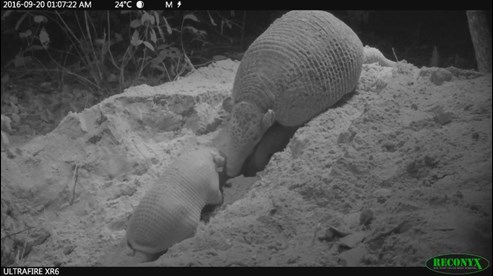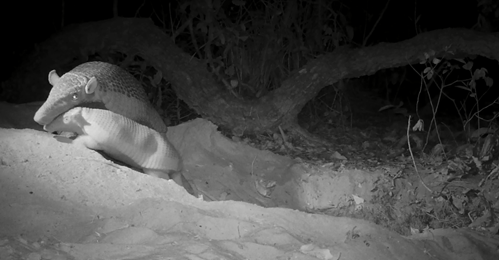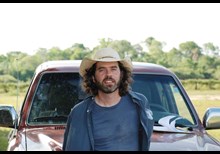It’s a boy!
25/10/2016 in Conservation

© Photo by Justin Purefoy, Maramedia
We could not be happier.
Danilo Kluyber (project veterinarian), Mario Henrique Alves (veterinarian trainee), and I set off to the Pantanal on 15 September. You may remember that an independent TV company, Maramedia, is filming a documentary on the project.
Although they had finished filming in August, they decided to make a quick trip back to try to capture images of this new baby giant armadillo. Justin Purefoy joined our team again - a long trip for him and a big gamble for the company! Thankfully we were successful in finding the baby giant armadillo and monitoring his progress.
On the first morning back in the field we rushed to the location where Gabriel had left two video cameras. We hoped to locate the baby once again and confirm its existence. It is much harder now that Isabelle no longer has a functioning radio transmitter. When we arrived the burrow was empty. However, images showed a quick glimpse of a tiny giant armadillo! Although the images were very poor, they confirmed the presence of the baby. We then needed to locate the new nesting burrow, to find the baby. Easier said than done…
It took us ten hours to find the new nesting burrow. It was very hot, the forest was full of ticks and it felt like searching for a needle in a haystack. We first found an abandoned nesting burrow about 150m from the original burrow. This not only lifted our spirits, but helped to give us a better sense of where to search.
Finally, roughly 300m from the original burrow we found a large sandy space. This was it! When an adult armadillo leaves the nesting burrow, they carefully cover and close the entrance. You would never guess there was a precious, tiny giant armadillo beneath the mound of sand. Had we not witnessed this behaviour when following Alex, we could easily have walked right by it.
For the next two weeks, we maintained cameras on the burrow, as well as two further burrows that Isabelle dug. The camera images revealed a beautiful, chubby, shiny two month old male – a miniature version of his mother. We can tell his age through the data we collected with Alex: his size and colouring are the biggest clues.
The scales on his head had just started to darken, and at the end of the expedition, the scales on the rest of his body had also darkened. We also studied his mother’s behaviour and the amount of time she spent with him, as well as the baby’s behaviour and interaction with his mother. The most important piece of data we have acquired thanks to this new baby is our first estimate for inter-birth rates.

It has been three years since this female, Isabelle, had her last baby. Once again she had a single pup. The reproduction study led by Camila Luba seems to indicate that animals reach sexual maturity only after their fifth year. Therefore it takes a long time for them to reach sexual maturity and they produce only one baby every three years. You can tell by these numbers that the growth rate of giant armadillo populations is VERY low. This means they cannot recover easily from any threats or decrease in numbers. This species can very easily and rapidly become extinct locally. This new data is crucial to our understanding of the species and requires long-term data sets.
No new giant armadillos were caught during the most recent September expedition. We did, however, monitor the three females and the sub-adult male we had previously been following. We checked on all the giant anteaters and even caught a new female.
For several days we tried to see the female giant anteater, Berenice, and her baby. She was in a deep forested area and as it was very dry she could easily hear us coming as the forest crackled under our feet. On the last evening before we left, we only caught a quick glance of her. We did not see the baby that should still be on her back. At that age she may have left it hidden and come back for it later. I was frustrated to leave without getting all the answers.
You may remember we are running a pilot study on giant armadillo detectability through camera traps in areas where we know the density of animals. Lessons learned from this work will be invaluable for our work in the Cerrado.
As we left the Pantanal, Gabriel Massocato and Yuri Ribeiro came to the ranch to collect all the cameras from the first grid and install all 25 of them in a new area. Gabriel is happy to report that giant armadillos were photographed on seven occasions, we believe consisting of three different individuals.
Finally, some further good news. We have come to the realisation that our knowledge on giant armadillos should not be limited to the Pantanal and Cerrado regions. With this in mind, we are very pleased to share the news that, thanks to the Association of Zoos & Aquariums – Conservation Grants Fund, we will be able to expand our work to the Atlantic Forest, an important development for the state habitat conservation measures.
 Until next time, all the best from Brazil!
Until next time, all the best from Brazil!
Arnaud
Featured Articles

An update from the Budongo Forest
19/04/2024 in Conservation

Edinburgh Zoo named best zoo in Scotland
15/04/2024 in Edinburgh Zoo
Latest News
-
Blog

26/02/2024
Looking back at a successful 2023 for giant armadillo conservation
Our charity has worked with Dr Arnaud Desbiez and his team at the Wildlife Conservation Institute (ICAS) in Brazil for over a decade to safeguard endangered giant armadillos, giant anteaters and their threatened habitat. This team has discovered nearly everything that is currently known about giant armadillos and has made incredible strides in making habitats and roads safer for giant anteaters.
-
News

21/04/2023
Twin armadillos born at Edinburgh Zoo
The Royal Zoological Society of Scotland (RZSS) is celebrating the birth of twin male large hairy armadillos at Edinburgh Zoo.
-
News

15/06/2022
Truckloads of support for threatened wildlife in Brazil
A new 4x4 vehicle, co-funded by the Royal Zoological Society of Scotland (RZSS), will enable conservationists in Brazil to continue their vital work saving endangered giant anteaters and giant armadillos across three different ecosystems.
-
Blog

11/05/2022
A GIANT update
Our charity has worked with Arnaud and his team at the Wildlife Conservation Institute (ICAS) in Brazil for over a decade to safeguard endangered giant armadillos, giant anteaters and their threatened habitat.

























Follow EZ